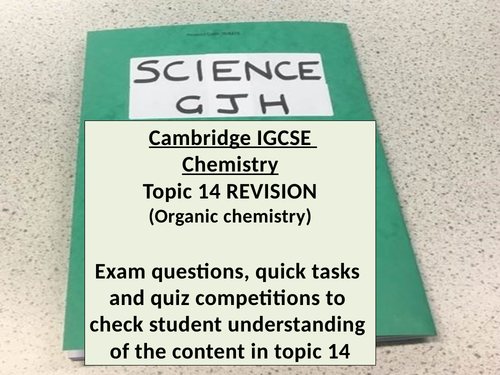






This is an engaging revision lesson which uses a range of exam questions, understanding checks, quiz tasks and quiz competitions to enable students to assess their understanding of the content within topic 14 (Organic chemistry) of the CIE IGCSE Chemistry (0620) specification. The lesson covers the content in both the core and supplement sections of the specification and therefore can be used with students who will be taking the extended papers as well as the core papers.
The specification points that are covered in this revision lesson include:
CORE
- Name and draw the structures of methane, ethane, ethene, ethanol, ethanoic acid and the products of their reactions
- State the type of compound present, given a chemical name ending in -ane, -ene, -ol, or -oic acid or a molecular structure
- Describe petroleum as a mixture of hydrocarbons and its separation into useful fractions by fractional distillation
- Describe the properties of molecules within a fraction
- Describe the concept of homologous series as a ‘family’ of similar compounds with similar chemical properties due to the presence of the same functional group
- Describe the properties of alkanes
- Describe the bonding in alkanes
- Describe the manufacture of alkenes and of hydrogen by cracking
- Distinguish between saturated and unsaturated hydrocarbons:
- Define polymers as large molecules built up from small units (monomers)
SUPPLEMENT
- Name and draw the structures of the unbranched alkanes, alkenes (not cis-trans), alcohols and acids containing up to four carbon atoms per molecule
- Name and draw the structural formulae of the esters which can be made from unbranched alcohols and carboxylic acids, each containing up to four carbon atoms
- Recall that the compounds in a homologous series have the same general formula
- Understand that different polymers have different units and/or different linkages
- Describe the structure of proteins
The students will thoroughly enjoy the range of activities, which include quiz competitions such as “Are you on FORM” where they compete to be the 1st to name an organic compound from its formula whilst crucially being able to recognise the areas of this topic which need their further attention. This lesson can be used as revision resource at the end of the topic or in the lead up to mocks or the actual GCSE exams
Get this resource as part of a bundle and save up to 50%
A bundle is a package of resources grouped together to teach a particular topic, or a series of lessons, in one place.
Something went wrong, please try again later.
This resource hasn't been reviewed yet
To ensure quality for our reviews, only customers who have purchased this resource can review it
Report this resourceto let us know if it violates our terms and conditions.
Our customer service team will review your report and will be in touch.